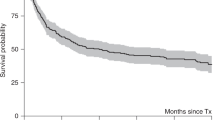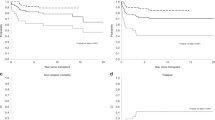Abstract
A major limitation of ABMT for relapsed/refractory Hodgkin’s disease is disease recurrence post-transplantation. We retrospectively reviewed 68 patients undergoing ABMT from January 1987 to June l993. All received a uniform preparatory regimen (CBV). The median patient age was 30; 75% received prior radiation therapy and all patients received prior chemotherapy. Thirty-one percent presented at the time of transplantation with tumor masses larger than 10 cm. Sixty-two percent received autologous marrow alone and 38% PBPC with or without autologous bone marrow. Overall and progression-free survival are 43 and 36% at 5 years. Median follow-up for survivors is 59 months. Multivariate analysis revealed that tumor bulk was the most powerful poor prognostic factor for both survival and progression-free survival. Those transplanted with non-bulky tumors had an overall survival and progression-free survival of 52 and 44%, respectively, compared to those transplanted with bulky tumors who had an overall survival and progression-free survival of 22 and 16% (P = 0.03 and P = 0.04, respectively). Twenty-seven patients have relapsed. Four relapsed more than 2 years after ABMT. Four of the 27 patients who have relapsed remain alive, two without evidence of disease. The time after transplant to relapse was prognostically important, with no patients who relapsed within 6 months of ABMT still being alive, compared with 25% of patients who relapsed 7 or more months after ABMT who are still alive. We conclude that salvage therapy for relapse after ABMT is appropriate, as some patients may achieve prolonged survival. The time from transplant to relapse is an important survival predictor.
This is a preview of subscription content, access via your institution
Access options
Subscribe to this journal
Receive 12 print issues and online access
$259.00 per year
only $21.58 per issue
Buy this article
- Purchase on Springer Link
- Instant access to full article PDF
Prices may be subject to local taxes which are calculated during checkout
Similar content being viewed by others
Author information
Authors and Affiliations
Rights and permissions
About this article
Cite this article
Bolwell, B., Kalaycio, M., Goormastic, M. et al. Progressive disease after ABMT for Hodgkin’s disease. Bone Marrow Transplant 20, 761–765 (1997). https://doi.org/10.1038/sj.bmt.1700974
Received:
Accepted:
Issue Date:
DOI: https://doi.org/10.1038/sj.bmt.1700974
Keywords
This article is cited by
-
Retrospective analysis of prognosticators in patients with relapsed Hodgkin’s Lymphoma treated with autologous transplant: results of a single center
Medical Oncology (2013)
-
Intensive conditioning regimen of etoposide (VP-16), cyclophosphamide and carmustine (VCB) followed by autologous hematopoietic stem cell transplantation for relapsed and refractory Hodgkin's lymphoma
Bone Marrow Transplantation (2008)
-
Factors associated with survival in patients with progressive disease following autologous transplant for lymphoma
Bone Marrow Transplantation (2003)
-
Progressive disease following autologous transplantation in patients with chemosensitive relapsed or primary refractory Hodgkin's disease or aggressive non-Hodgkin's lymphoma
Bone Marrow Transplantation (2003)
-
High dose chemoradiotherapy with autologous hematopoietic stem cell transplantation in the treatment of advanced Hodgkin’s lymphoma: A report of 11 cases
Chinese Journal of Cancer Research (2002)



